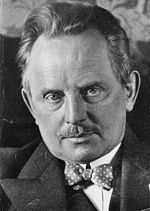Oskar Barnack
| Oskar Barnack | |
|---|---|
|
Oskar Barnack | |
| Born |
1 November 1879 Lynow, Nuthe-Urstromtal, Germany |
| Died |
16 January 1936 (aged 56) Bad Nauheim, Germany |
| Nationality | Germany |
|
Engineering career | |
| Significant projects | camera |
Oskar Barnack (November 1, 1879 – January 16, 1936) was a German optical engineer,[1] precision mechanic, industrial designer and the father of 35 mm photography.
Life and career
In 1911, Barnack was in charge of microscope research for Ernst Leitz at Wetzlar, Hesse, Germany (now a separate company Leica Microsystems). He was an enthusiastic photographer, but the heavy equipment of the day was difficult for him to handle due to his poor health. In 1912, he constructed a 35 mm movie camera.[1]
Between 1913 and 1914 he was head of development at Leitz. He was the driving force behind the making of the first mass-marketed 135 camera and the introduction of the 24×36 mm film format which came to be known as 35mm. Barnack suffered from asthma, and sought to reduce the size and weight of cameras and supporting equipment used for outdoor photography. His 35 mm design helped introduce the concept of exposing a small area of film to create a negative, then enlarging the image in a darkroom.[2]
The onset of World War I kept the first Leica from being manufactured until 1924, and it was not introduced to the public until 1925, when Leica's chief, the optician Ernst Leitz, took a gamble and authorized the production of 1,000 cameras.[2]
Leica stood for Leitz Camera. Instead of the exposure plates used in past Leitz cameras, the Leica used a standardized film strip, adapted from 35 mm Eastman Kodak roll-film. Barnack decided that the 18 x 24 mm (3:4 aspect ratio) standard movie frame was not large enough for good still photo quality with the films of the day and doubled the frame size to 24 x 36 mm (2:3 aspect ratio), with the image horizontal instead of vertical.
Lynow, Barnack's birthplace and currently a municipality of Brandenburg, has a museum dedicated to him and his work.
On the hundredth anniversary of Barnack's birth, World Press Photo instituted the Oskar Barnack Award;[3] this is now administered by Leica Camera.[4]
References
- ↑ 1.0 1.1 Lance Day, Ian McNeil, ed. (1996). Biographical Dictionary of the History of Technology. Routledge. ISBN 0-415-19399-0.
- ↑ 2.0 2.1 Late to Digital, Leica Slow to Refocus, Wall Street Journal, September 16, 2008, p. B1
- ↑ "1979, Floris Bergkamp, Individual awards, Oskar Barnack Award", World Press Photo. Accessed 25 May 2014.
- ↑ "Leica Oskar Barnack Award". Accessed 25 May 2014.
External links
| Wikimedia Commons has media related to Leica. |
- Leica Camera AG
- Leica History by Thorsten Overgaard
- "Oskar Barnack" International Photography Hall of Fame
- Oskar Barnack films on the European Film Gateway
|
| ||||||||||||||||||||||||||||||||||||||
